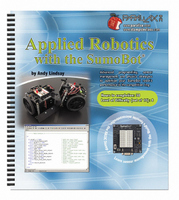27403 Parallax Inc, 27403 Datasheet - Page 89

27403
Manufacturer Part Number
27403
Description
GUIDE APP ROBOTCS W/SUMOBOT V1.0
Manufacturer
Parallax Inc
Datasheet
1.27404.pdf
(266 pages)
Specifications of 27403
Accessory Type
Manual
Product
Microcontroller Accessories
Lead Free Status / RoHS Status
Contains lead / RoHS non-compliant
For Use With/related Products
SumoBot®
Lead Free Status / RoHS Status
Lead free / RoHS Compliant, Contains lead / RoHS non-compliant
- Current page: 89 of 266
- Download datasheet (6Mb)
Testing for Sources of IR Interference
Fluorescent lights have a part called a ballast built into them. The ballast is responsible
for amplifying the AC outlet voltage to a level that is high enough to make the gas inside
the glass tube fluoresce and emit light. Some of the electronic ballasts built into more
recently manufactured fluorescent lights can be a problem for the infrared detectors.
These ballasts cause the light to send off a signal that the IR receiver is sensitive to.
When the IR receiver detects this signal, it sends a low signal to the BASIC Stamp, and
the BASIC Stamp thinks an object has been detected when it really hasn't. To make
matters more confusing, certain other devices like handheld remotes and video cameras
or camcorders can also send out interfering signals.
It's best to stage your SumoBot competitions well away from fluorescent lights and other
devices that broadcast this kind of interference, either by turning off the light, or moving
the competition ring. With a few modifications to TestFrontIrObjectDetectors.bs2, you
can then use your SumoBot as an IR interference sniffer. To test and make sure the
SumoBot can indeed detect IR interferences, simply run the unmodified version of
TestFrontIrObjecDetectors.bs2 in the other SumoBot. Point the two SumoBots at each
other, and the one running the modified code should sense the IR from the other
SumoBot and sound the alarm.
The key to making an IR interference sniffer is to not send out any IR before checking
the IR receiver's output.
IrLedLeft
receivers are still detecting an infrared signal in the neighborhood of 38.5 kHz, it must
mean it's coming from a source of IR interference. So, sound the alarm.
The next example program started as TestFrontIrObjectDetectors.bs2. The two most
important changes that convert TestFrontObjectDetectors.bs2 to IrInterferenceSniffer.bs2
are:
(1) removing the
(2) adding code that makes sounds if either of the IR receivers tell the BASIC Stamp
they detect an infrared signal.
and
IrLedRight
FREQOUT
In other words, remove the
pins. If the SumoBot's infrared headlights are off, but it the
commands, and
FREQOUT
commands to the
Related parts for 27403
Image
Part Number
Description
Manufacturer
Datasheet
Request
R

Part Number:
Description:
Microcontroller Modules & Accessories DISCONTINUED BY PARALLAX
Manufacturer:
Parallax Inc

Part Number:
Description:
BOOK UNDERSTANDING SIGNALS
Manufacturer:
Parallax Inc
Datasheet:

Part Number:
Description:
COMPETITION RING FOR SUMOBOT
Manufacturer:
Parallax Inc
Datasheet:

Part Number:
Description:
TEXT INFRARED REMOTE FOR BOE-BOT
Manufacturer:
Parallax Inc
Datasheet:

Part Number:
Description:
BOARD EXPERIMENT+LCD NX-1000
Manufacturer:
Parallax Inc
Datasheet:

Part Number:
Description:
CONTROLLER 16SERVO MOTOR CONTROL
Manufacturer:
Parallax Inc
Datasheet:

Part Number:
Description:
BASIC STAMP LOGIC ANALYZER
Manufacturer:
Parallax Inc
Datasheet:

Part Number:
Description:
IC MCU 2K FLASH 50MHZ SO-18
Manufacturer:
Parallax Inc
Datasheet:














